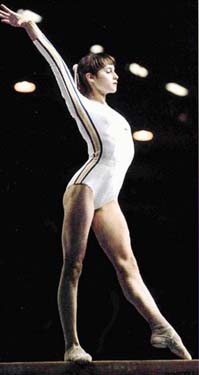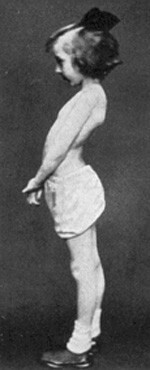Vous pouvez écouter le podcast de Sarah sur ce sujet ici :
Comment la réponse à l'action mène au mal de dos
Comment et pourquoi nous développons les courbes naturelles de notre colonne vertébrale
Au cours des premiers mois de la vie, nous sommes totalement impuissants, incapables de ramper ou même de nous asseoir par nous-mêmes. Nous avons passé neuf mois recroquevillés en position fœtale et n'avons pas encore pris le contrôle des muscles extenseurs de notre cou et de notre dos, qui permettent us lever la tête et cambrer le bas du dos.
Vers l'âge de trois mois, on réussit enfin à décoller la tête du sol en position couchée sur le ventre. Quelques mois plus tard, les muscles du bas du dos sont activés, permettant us ramper, s'asseoir et éventuellement se tenir debout et marcher.
Once we are using the extensor muscles of our back and neck on a regular basis, the cervical and lumbar curves in our spine will begin to develop. These are called lordotic curves, and they curve in the opposite direction as the kyphotic curves of the thoracic and sacral portions of the spine.
The natural kyphotic and lordotic curves of the spine are essential to our spine’s ability to absorb shock; they allow the spine to function like a big spring. If we didn’t have these curves, our vertebrae would be stacked on top of each other in a straight line, and compressive forces would cause a great deal of damage and pain.

La réponse d'action
In infants, the contraction of the back and neck muscles in response to the instinctive desire to become mobile is called the Landau Reflex. But even after we learn how to stand, walk and run, our extensor muscles automatically contract every time we want to get up and go; this is the action response. We arch our back, lift our head, pull our shoulders back, stick out our chests, straighten our knees, and rotate our legs outward.
Our action response is also triggered by eustress, or positive stress, such as giving a presentation or meeting our new boss. Whenever we want to make a good impression and be on our game, we instinctively contract our back muscles so that we stand up straight, look taller, and appear to be confident. This posture prepares us both physically and psychologically for action.

Nous associons inconsciemment cette posture droite, souvent cambrée, à la confiance, la force, la jeunesse et la beauté. Ce n'est pas un hasard si l'armée entraîne les soldats à se tenir droit et à bomber le torse. La posture d'action-réponse montre à l'ennemi qu'il est prêt pour le combat. Et nous trouvons beaucoup plus agréable de regarder quelqu'un qui se tient droit plutôt que courbé ; imaginez-vous en train de regarder un danseur ou un patineur sur glace qui s'affaissait pendant qu'il se produisait.
Les effets négatifs de la réponse d'action
Jusqu'à présent, la réponse à l'action sonne plutôt bien. Il prépare us pour l'action et fait automatiquement us regarder et se sentir plus confiant.
When our action response is triggered once in a while, it is great. But when it’s activated constantly by a high-stress job or practiced repetitively as part of physical training, the pattern of muscular contraction becomes learned. So even after you retire from your stressful job or quit dancing, your back muscles remain habitually tight, causing soreness, pain, and often structural damage to intervertebral discs.
Once the action response has become habitual, and we are subconsciously holding our lower back muscles tight all the time, pain becomes pretty much inevitable. When the extensor muscles of the back are chronically contracted, they will typically pull the lumbar spine into hyperlordosis. The exaggerated arching of the lower back compresses the discs in between the lumbar vertebrae, often causing the discs to bulge or herniate. People with tight lower back muscles often experience sciatica due to compression of the sciatic nerve as it exits the spine in between the lumbar vertebrae. Tight lower back muscles also compress the sacroiliac joint, causing pain and inflammation, and potentially shifting the joint out of alignment.

Inverser les effets de la réponse d'action
Les effets négatifs de la réponse d'action peuvent être prévenus, atténués et souvent éliminés en rééduquant le système nerveux pour libérer la contraction musculaire chronique dans les muscles du dos. Afin de rééduquer le système nerveux, nous devons passer par un processus d'apprentissage actif impliquant des mouvements lents et conscients.
The most effective way to teach the nervous system to release chronic muscular contraction is with the movement technique of pandiculation. Pandiculation sends accurate biofeedback to the nervous system, resetting the gamma feedback loop, which controls the resting level of tension in our muscles. Thomas Hanna developed the technique of pandiculation and incorporated into his system of neuromuscular education called Clinical Somatic Education.
Consultez ces autres articles sur les réflexes, le stress et la posture :
Comment la réponse de retrait conduit à une posture arrondie
Comment le réflexe fléchisseur conduit à une douleur unilatérale
Lecture recommandée:
The Pain Relief Secret: How to Retrain Your Nervous System, Heal Your Body, and Overcome Chronic Pain by Sarah Warren, CSE
Somatics: Reawakening the Mind’s Control of Movement, Flexibility and Health by Thomas Hanna

